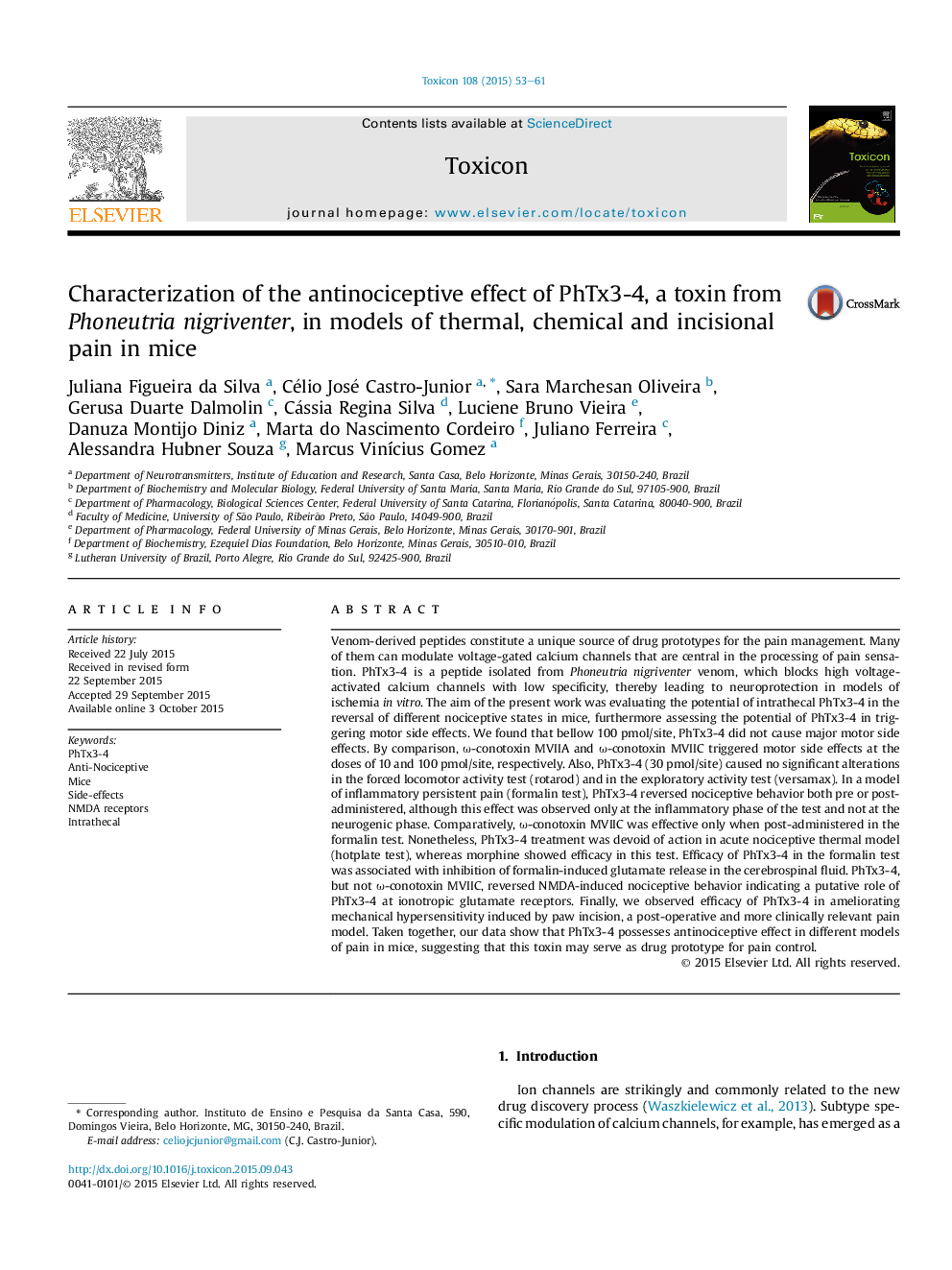| کد مقاله | کد نشریه | سال انتشار | مقاله انگلیسی | نسخه تمام متن |
|---|---|---|---|---|
| 8395132 | 1544128 | 2015 | 9 صفحه PDF | دانلود رایگان |
عنوان انگلیسی مقاله ISI
Characterization of the antinociceptive effect of PhTx3-4, a toxin from Phoneutria nigriventer, in models of thermal, chemical and incisional pain in mice
دانلود مقاله + سفارش ترجمه
دانلود مقاله ISI انگلیسی
رایگان برای ایرانیان
کلمات کلیدی
موضوعات مرتبط
علوم زیستی و بیوفناوری
بیوشیمی، ژنتیک و زیست شناسی مولکولی
بیوشیمی، ژنتیک و زیست شناسی مولکولی (عمومی)
پیش نمایش صفحه اول مقاله

چکیده انگلیسی
Venom-derived peptides constitute a unique source of drug prototypes for the pain management. Many of them can modulate voltage-gated calcium channels that are central in the processing of pain sensation. PhTx3-4 is a peptide isolated from Phoneutria nigriventer venom, which blocks high voltage-activated calcium channels with low specificity, thereby leading to neuroprotection in models of ischemia in vitro. The aim of the present work was evaluating the potential of intrathecal PhTx3-4 in the reversal of different nociceptive states in mice, furthermore assessing the potential of PhTx3-4 in triggering motor side effects. We found that bellow 100 pmol/site, PhTx3-4 did not cause major motor side effects. By comparison, Ï-conotoxin MVIIA and Ï-conotoxin MVIIC triggered motor side effects at the doses of 10 and 100 pmol/site, respectively. Also, PhTx3-4 (30 pmol/site) caused no significant alterations in the forced locomotor activity test (rotarod) and in the exploratory activity test (versamax). In a model of inflammatory persistent pain (formalin test), PhTx3-4 reversed nociceptive behavior both pre or post-administered, although this effect was observed only at the inflammatory phase of the test and not at the neurogenic phase. Comparatively, Ï-conotoxin MVIIC was effective only when post-administered in the formalin test. Nonetheless, PhTx3-4 treatment was devoid of action in acute nociceptive thermal model (hotplate test), whereas morphine showed efficacy in this test. Efficacy of PhTx3-4 in the formalin test was associated with inhibition of formalin-induced glutamate release in the cerebrospinal fluid. PhTx3-4, but not Ï-conotoxin MVIIC, reversed NMDA-induced nociceptive behavior indicating a putative role of PhTx3-4 at ionotropic glutamate receptors. Finally, we observed efficacy of PhTx3-4 in ameliorating mechanical hypersensitivity induced by paw incision, a post-operative and more clinically relevant pain model. Taken together, our data show that PhTx3-4 possesses antinociceptive effect in different models of pain in mice, suggesting that this toxin may serve as drug prototype for pain control.
ناشر
Database: Elsevier - ScienceDirect (ساینس دایرکت)
Journal: Toxicon - Volume 108, 15 December 2015, Pages 53-61
Journal: Toxicon - Volume 108, 15 December 2015, Pages 53-61
نویسندگان
Juliana Figueira da Silva, Célio José Castro-Junior, Sara Marchesan Oliveira, Gerusa Duarte Dalmolin, Cássia Regina Silva, Luciene Bruno Vieira, Danuza Montijo Diniz, Marta do Nascimento Cordeiro, Juliano Ferreira, Alessandra Hubner Souza,